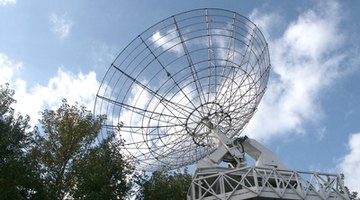Basics in Parabolic Roof Design
A parabola is a kind of conic section. Imagine, for example, holding an ice cream cone with its opening straight downward, and then using a laser to cleanly cut through the cone.

If you cut at any angle aside from perfectly horizontally or perfectly vertically and through the tip of the cone, then the exposed edge of your ice cream cone will form a parabola. The parabola shape can be evidence in roof design, either in the saddle-like shape of a hyperbolic paraboloid or in the nearly-rounded shapes of paraboloids.
Hyperbolic Paraboloids
Also known as a "saddle roof," the hyperbolic parabola is a shape easily recognizable among the popular brands of saddle-shaped potato chips that come stacked in tubular cans. Roofs may use the hyperbolic parabola form, as well. In essence, a hyperbolic paraboloid is composed of two intersecting fields of straight lines, each line at a slightly different angle. Therefore, a hyperbolic parabola can produce a seemingly rounded shape using straight joists. The J.S. Dorton Arena in Raleigh, North Carolina, built in 1952, features a parabolic arch extended outward from opposite eaves; the roof itself forms a hyperbolic paraboloid. The two arches support a latticework of straight cables that support the roof without the need for any interior columns.
Parabolic "Domes"
Though they are not true spherical domes, some parabolic roofs are best described as resembling domes or cupolas. For example, Toronto's Rogers Centre—formerly the SkyDome—features parabolic sections that work together to form the stadium's rounded, retractable roof. In the case of Rogers Centre, three panels cover the whole of the circular stadium. In addition, a fourth panel locks in over the three parabolic sections, moving to the side when the roof retracts. Two of the moving panels are parabolic, lending the stadium roof its subtly domed profile.
Small-Scale Parabolic Roofs
While parabolic roofs make impressive covers for modernist masterpieces or complex moving roofs, they can also be applied for small-scale projects. For a single-family home in Aptos, California, architect Marcel Sedletzky used a parabolic roof to give the home an understated, "tent-like" quality. Using Douglas fir beams, Sedletzky created the illusion of an arch. In fact, the straight fir beams are all angled around a center beam. However, the illusion of a curve helps the house blend into its beachfront environs, like a dune or a drooping tent. You can also build a small-scale DIY parabolic roof out of rigid armatures and flexible coverings or strengthened plaster.
References
Writer Bio
Danielle Hill has been writing, editing and translating since 2005. She has contributed to "Globe Pequot" Barcelona travel guide, "Gulfshore Business Magazine," "Connecting Lines: New Poetry from Mexico" and "The Barcelona Review." She has trained in neuro-linguistic programming and holds a Bachelor of Arts in comparative literature and literary translation from Brown University.
Photo Credits
- antenne image by pucci raf from Fotolia.com
- antenne image by pucci raf from Fotolia.com
More Articles



